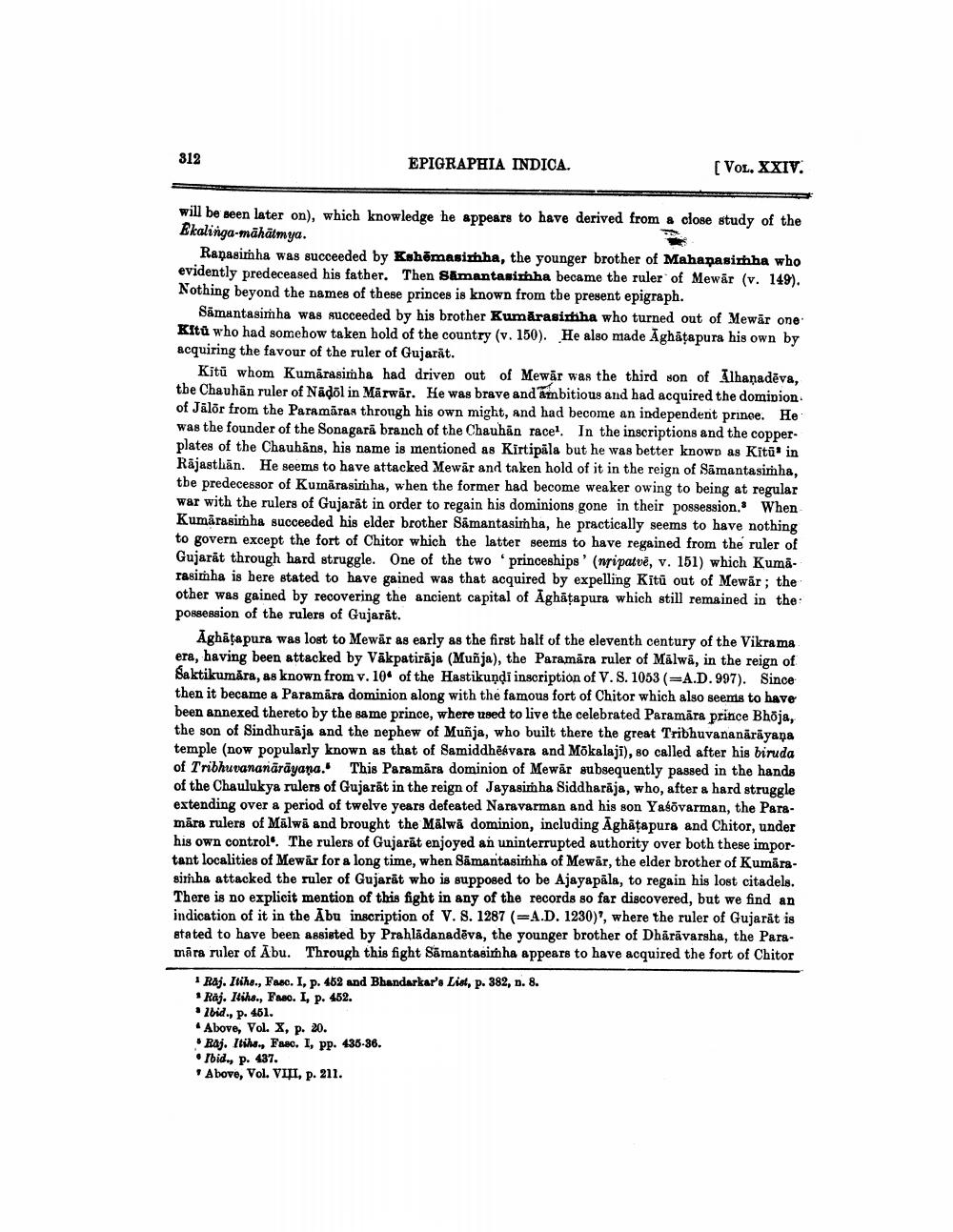________________
312
EPIGRAPHIA INDICA.
[VOL. XXIV.
will be seen later on), which knowledge he appears to have derived from a close study of the Ekalinga-māhātmya.
Ranasimha was succeeded by Kshēmasimha, the younger brother of Mahanasimha who evidently predeceased his father. Then Samantasimha became the ruler of Mewär (v. 149). Nothing beyond the names of these princes is known from the present epigraph.
Sämantasimha was succeeded by his brother Kumārasimha who turned out of Mewār one Kitū who had somehow taken hold of the country (v. 150). He also made Āghitapura his own by acquiring the favour of the ruler of Gujarat.
Kitü whom Kumarasimha had driven out of Mewar was the third son of Ilhanadēva, tbe Chauhan ruler of Nadol in Mārwär. He was brave and ambitious and had acquired the dominion of Jälór from the Paramāras through his own might, and had become an independent prince. He was the founder of the Sonagarā branch of the Chauhan racelIn the inscriptions and the copperplates of the Chauhans, his name is mentioned as Kirtipäla but he was better known as Kitūl in Rajasthān. He seems to have attacked Mewar and taken hold of it in the reign of Samantasimha, tbe predecessor of Kumārasimha, when the former had become weaker owing to being at regular war with the rulers of Gujarat in order to regain his dominions gone in their possession. When Kumārasimha succeeded his elder brother Sämantasimha, he practically seems to have nothing to govern except the fort of Chitor which the latter seems to have regained from the ruler of Gujarat through hard struggle. One of the two princeships' (nripatvë, v. 151) which Kumarasimha is bere stated to have gained was that acquired by expelling Kitu out of Mewar; the other was gained by recovering the ancient capital of Aghātapura which still remained in the possession of the rulers of Gujarat.
Aghātapura was lost to Mewar as early as the first balt of the eleventh century of the Vikrama era, having been attacked by Väkpatirāja (Muñja), the Paramāra ruler of Malwā, in the reign of Saktikumára, as known from v. 10° of the Hastikundi inscription of V. S. 1053 (=A.D. 997). Since then it became a Paramāra dominion along with the famous fort of Chitor which also seems to have been annexed thereto by the same prince, where used to live the celebrated Paramāra prince Bhoja, the son of Sindhurāja and the nephew of Muñja, who built there the great Tribhuvananārāyana temple (now popularly known as that of Samiddhēkvara and Mokalaji), so called after his biruda of Tribhuvananārāyana. This Paramara dominion of Mewar subsequently passed in the hands of the Chaulukya rulers of Gujarat in the reign of Jayasimha Siddharāja, who, after a hard struggle extending over a period of twelve years defeated Naravarman and his son Yaśõvarman, the Paramára rulers of Malwā and brought the Mālwă dominion, including Āghātapura and Chitor, under his own control. The rulers of Gujarat enjoyed an uninterrupted authority over both these important localities of Mewar for a long time, when Sāmantasimha of Mewar, the elder brother of Kumārasimha attacked the ruler of Gujarät who is supposed to be Ajayapāla, to regain his lost citadels. There is no explicit mention of this fight in any of the records so far discovered, but we find an indication of it in the Abu inscription of V. S. 1287 (=A.D. 1230)', where the ruler of Gujarat is stated to have been assisted by Prahladanadēva, the younger brother of Dhårävarsha, the Paramāra ruler of Abu. Through this fight Sämantasimha appears to have acquired the fort of Chitor
Raj. Itihs., Fasc. I, p. 452 and Bhandarkar's List, p. 382, n. 8.
Räj. Ilihe., Faso. I, p. 452. .Ibid., p. 461. . Above, Vol. X, p. 20. . Raj. Itihe. Fasc. I, pp. 435-36.
Toid., p. 437. . Above, Vol. VIII, p. 211.




